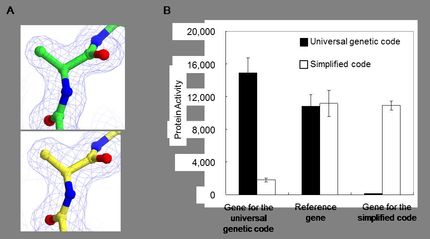Designer proteins provide new information about the body's signal processes
Advertisement
Proteins play a fundamental role in almost all biological processes. They consist of chains constructed of up to 20 different amino acids, and their composition, structure and function are controlled by the genetic code. Brilliant minds at the Center for Biopharmaceuticals are now attempting to rewrite the core function of proteins by making alterations in their molecular backbone, for example. By combining biological and chemical methods, researchers are able to design semi-synthetic proteins with almost no regard to the limitations of nature:
"Proteins can be regulated to perform specific biochemical tasks. We have used a technology that allows us to make changes to the molecular backbone of the protein and have thus created 22 completely new designer proteins on the basis of recognised material. Using advanced chemical-biological methods, we made the minuscule changes to the backbone of one of the most frequently occurring protein domains – a kind of fixed, independent module that features in a range of proteins. We then examined how the designer proteins bind to other proteins in the body, which allowed us to analyse the role of the specific protein domain in the body's vital signal processes," relates Søren W. Pedersen, postdoc.
All the cells in the body communicate via receptor proteins that are located in the cell membrane. This activates proteins inside the cell, causing specific effects which, in turn, stimulate the body to execute a variety of functions.
"Our designer proteins show us precisely how and where a bond is formed. This provides unique molecular understanding of the protein domain and a number of key protein bonds in the organism. For example the designer proteins bind to a range of receptors in the body – receptor interactions that are important targets for pharmaceuticals intended to treat stroke, pain and depression. The new findings mean that in the long term, we will be able to design pharmaceuticals that bind more strongly and more accurately to specific sites in the organism."
The fundamental findings have been published in the scientific journal Nature Communications.
From 'on/off switch' to 'advanced dimmer'
Pharmaceuticals generally function by binding to a specific receptor that is involved in a given illness process – thus halting the damaging effect. Unfortunately, this strategy often generates side effects as the process simultaneously shuts down a number of beneficial functions. In recent years, interest has therefore arisen in a different strategy in which the pharmaceutical does not affect the receptor directly, but alters the interactions that the receptor has with proteins inside the cell. In other words, instead of simply switching the function of the receptor on and off, the objective is now to control parts of the receptor's effects. It is here that designer proteins can come to play a key role:
"The capacity to manipulate proteins has led to important breakthroughs in biotechnology and biomedicine. Proteins can often target specific processes in the cells with a high degree of accuracy – and at the Center for Biopharmaceuticals we are combining chemical synthesis and biological processes to find out more about the molecular interactions that may be of significance to biological pharmaceuticals," explains Professor Kristian Strømgaard, head of the Center for Biopharmaceuticals at the University of Copenhagen.

















































